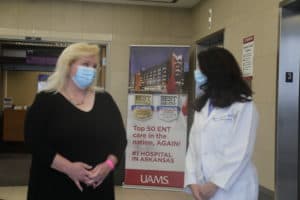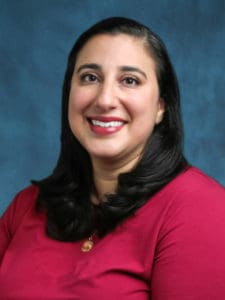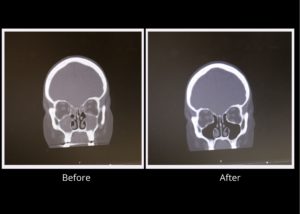View Larger Image

Cathy Christiansen at her home in Bald Knob.
Image by Bryan Clifton
Diagnosis of Aspirin-induced Inflammation is Key to Persistent Sinus Blockage
| Cathy Christiansen, of Bald Knob, was hospitalized at least seven times in the early part of 2019 with severe respiratory infections.
She had sinus surgery in July to clear her sinuses, but the problem persisted. By August, she was back in the hospital. Imaging showed her sinuses were completely blocked again.

Cathy Christiansen and one of her physicians, Alissa Kanaan, M.D. talk outside the ENT Clinic at UAMS.
“My doctor wanted to send me to the Mayo Clinic,” Christiansen said. “But I told them I would rather be sent to UAMS.”
Christiansen trusted the specialists at UAMS would be able to figure out what was wrong without her having to travel out of state. She and her husband, state Rep. Craig Christiansen, have an apartment in Little Rock.
Her doctor referred her to Alissa Kanaan, M.D., an otolaryngologist who offers endoscopic nasal and sinus surgery and treatment for chronic sinusitis.
“She was being treated for sinus infections and not getting better,” Kanaan said. “I knew the problem had to be bigger than just sinuses. She did not respond to the usual sinus treatments like antibiotics and surgery and had other symptoms like shortness of breath and fatigue. But we didn’t know at the time what it was.”
Kanaan consulted with Sheva Chervinskiy, D.O., an allergist-immunologist. The two physicians along with infectious disease specialists took a whole-team approach towards finding a diagnosis.
“Her sinuses behaved like a patient with cystic fibrosis or some kind of immune deficiency. Mold allergies are also pretty common in Arkansas,” Kanaan said. “We looked at many factors to determine why she was having this constant problem that would not go away.”
During one of her appointments, Christiansen had just received her flu and pneumonia shot the day before.
“My arms were swollen, I was in a lot of pain and I had difficulty breathing,” she said. “Dr. Kanaan suggested I stay in Little Rock that night and to go to the emergency room if it worsened. Then
she said to avoid ibuprofen or any other NSAIDs (nonsteroidal anti-inflammatory drugs).”
That suggestion was surprising to Christiansen because she often took ibuprofen. She switched to acetaminophen.
“That actually became a life-changing moment,” Christiansen said. “That’s when things started to come together that I had Aspirin Exacerbated Respiratory Disease (AERD).”
AERD is a chronic inflammatory disease that consists of adult-onset asthma, recurrent nasal polyps and sinusitis, and dangerous reactions to aspirin and other NSAIDs. It affects about seven
percent of adults with asthma, or 1.5 million people.
“AERD was low on our suspicion list early on because she was on the ibuprofen every day before I told her to stop taking it,” Kanaan said. “Normally, when we suspect AERD, it is because a patient has an almost immediate reaction that lands them in the emergency room. Ms. Christiansen was different. She was on a high daily dose so we initially ruled it out. When she got off, that gave us the lead to be able to diagnose her. She had a bad reaction after she’d taken one later by mistake.”
Kanaan did Christiansen’s second sinus surgery in March 2020. The difference in her sinus before and after surgery is clear to even an untrained eye.
Christiansen sees Kanaan and Chervinskiy for regular treatments. Her quality of life has improved tremendously and she hopes her story will help others who may have AERD. Many go for years before they’re diagnosed. She is grateful for the patient-centered, multidisciplinary approach that helped her find answers.
“Patient history is a helpful guide for us to understand what is going on,” Kanaan said. “It’s also very important to have a multidisciplinary approach to a difficult case like this. When we combine our opinions and training, we can reach a conclusion more quickly so the patient can feel better.
Christiansen also found support in the Samter’s Society, an advocacy group for those affected by AERD (which is also known as Samter’s Triad). Christiansen made sure Kanaan and Chervinskiy were listed on the site as doctors who treat the disease.
“Last year, I spent from Memorial Day to Labor Day living with my sister who was taking care of me,” Christiansen said. “I was concerned about living at my own home because we live on a farm with dogs, cats, horses and lots of grass. But with the diagnosis, treatments and the allergy shots, I am able to enjoy my life again. It has been a huge blessing for me to return to my life that I’ve chosen instead of living within the constraints of my illness.”


